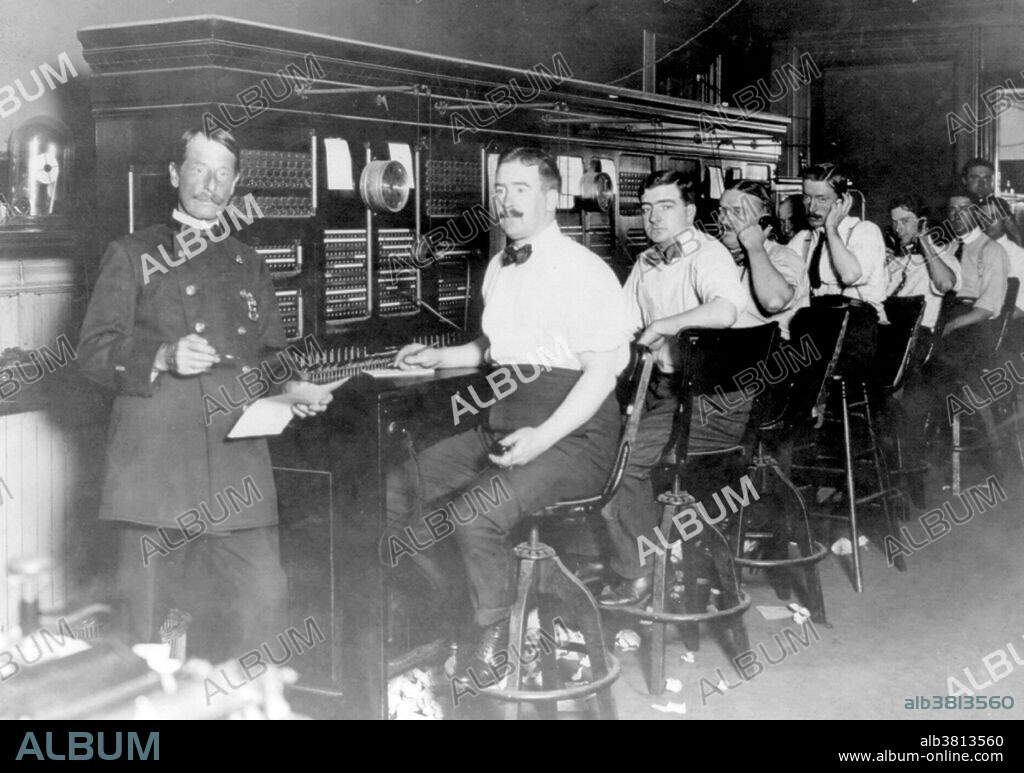alb3813560
NYC Police Department Telephone Operators, 1909

|
Add to another lightbox |
|
Add to another lightbox |



Title:
NYC Police Department Telephone Operators, 1909
Caption:
NYC Police Department telephone operators lined up at police headquarters switchboard, 1909. In the early days of telephony companies used manual telephone switchboards, and switchboard operators connected calls by inserting a pair of phone plugs into the appropriate jacks. Each pair of plugs was part of a cord circuit with a switch associated that let the operator participate in the call. Each jack had a light above it that lit when the telephone receiver was lifted. Lines from the central office were usually arranged along the bottom row. Before the advent of automatic exchanges, an operator's assistance was required for anything other than calling telephones across a shared party line. Callers spoke to an operator at a Central Office who then connected a cord to the proper circuit in order to complete the call. Automatic, or Dial systems were developed in the 1920s to reduce labor costs as usage increased, and to ensure privacy to the customer. Companies observed that women were generally more courteous to callers. However, a contributing factor to women entering this workforce was because women were paid from one half to one quarter of a man's salary. Photographed by Bain News Service, 1909.
Credit:
Album / LOC/Science Source
Releases:
Model: No - Property: No
Rights questions?
Rights questions?
Image size:
4500 x 3165 px | 40.7 MB
Print size:
38.1 x 26.8 cm | 15.0 x 10.6 in (300 dpi)
Keywords:
1900S • 1909 • 1990S • 20 XX TWENTIETH CENTURY • 20TH CENTURY • 20TH • 90S • AMERICA • AMERICAN • BAIN NEWS SERVICE • BREAKTHROUGH • BW • CELEBRITIES • CELEBRITY • COMMUNICATION • COPS • FAMOUS • GROUNDBREAKING • HEADQUARTERS • HISTORIC • HISTORICAL • HISTORY • IMPORTANT • INVENTION • MANUAL TELEPHONE EXCHANGE • MEN • MULTIPLE SWITCHBOARD • NEW YORK CITY • NINETIES • NINETIES, THE • NINETY DECADE • NOTABLE • NYC • OCCUPATION • OPERATORS • PHONE • PHOTO • PHOTOGRAPH • POLICE DEPARTMENT • POLICE • POLICEMEN • SCIENCE • SWITCHBOARD SYSTEM • SWITCHBOARD • TECHNOLOGICAL • TECHNOLOGY • TELE-COMMUNICATION • TELECOMMUNICATION • TELEPHONE OPERATORS • TELEPHONE • TELEPHONY • TWENTIETH CENTURY • UNITED STATES • US • USA • WELL-KNOWN
 Pinterest
Pinterest Twitter
Twitter Facebook
Facebook Copy link
Copy link Email
Email

